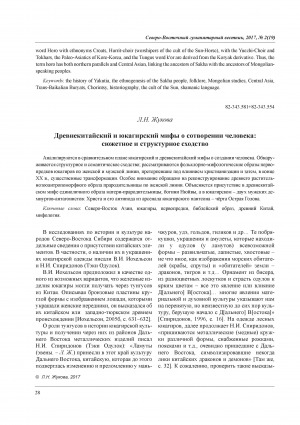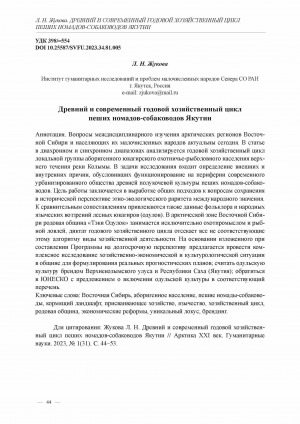Место работы автора, адрес/электронная почта: Институт гуманитарных исследований и проблем малочисленных народов Севера СО РАН, Отдел археологии и этнографи ; 677027, г. Якутск, ул. Петровского, 1 ; e-mail: zjukova@mail.ru ; http://igi.ysn.ru
Ученая степень, ученое звание: канд. ист. наук
Область научных интересов: Этнография и фольклор народов Севера.
ID Автора: SPIN-код: 7149-2901, РИНЦ AuthorID: 120280
Деятельность: С 1988 г. работает старшим научным сотрудником Сектора палеоазиатской филологии Института гуманитарных исследований и проблем малочисленных народов СО РАН.
Количество страниц: 6 с.
Water vehicles participating in the formation of economic specifications and spiritual values of stray hunting and fishing tribes of the Yukagirs of Upper Kolyma are considered. The water resources of the northern latitudes assumed the availability of specialized watercraft in accordance with the needs of nomadic life: easy shuttle traders and trailers, cargo and transport boats for migrating families with women, old people, and children. Means of conveyance could be used for military, exchange and other purposes. The transport fleet assumed differences in size and construction. Verkhnekolymsk Yukagirs in the late XIX - early XX centuries roamed on rafts of a triangular shape, dugout and boardwalk boats, single and multi-seat. Basic information on water vehicles was collected by V.I. Jochelson, supplemented by his materials Yu. B. Simchenko, who summarized data on ancient frame boats in the arsenal of anglers and wild reindeer hunters. Leather-framed boats existed in the Evens of Yakutia. Traces of their presence among the Tundra Yukagirs were identified by Yu. B. Simchenko. The author of this article received information from the American Eskimo about the existence of a raft of a triangular shape with leather tight. The question arises: are triangular rafts (Yukagir and Eskimo with leather tight) and Even’s frame boat the so-called cultural fossils, evidence of the existence of multi-seat vehicles for members of the clan in the distant past? It is assumed that the heavy boat of the Forest Yukaghirs is combined boat that joins elements of national vehicles and, possibly, Russian karbas, it is not considered unambiguously as Russian borrowing. During XX century in connection with serious socio-economic changes, the water transport of the Forest Yukagirs has changed significantly, the advantages of imported factory-made dural boats. At the end of XX - beginning of XXI centuries Forest Yukagirs Yasachnaya River in the Upper Kolyma in limited use preserved fishing board shuttle of three boards.
Жукова, Л. Н.
Средства передвижения у юкагиров: лодки (традиции и современность) / Жукова Л. Н. ; Институт гуманитарных исследований и проблем малочисленных народов Севера СО РАН // Народы и культуры Северной Азии в контексте научного наследия Г. М. Василевич : сборник научных статей / ответственный редактор Л. И. Миссонова ; редакционная коллегия: А. Н. Варламов, Н. И. Данилова, Е. Г. Маклашова [и др.] ; рецензенты: Т. В. Аргунова, Т. Г. Басангова, В. Н. Давыдов ; ответственный за выпуск М. П. Дьяконова. - Якутск : ИГИиПМНС СОРАН, 2020. - С. 89-94. - DOI: 10.25693/Vasilevich.2020.014
DOI: 10.25693/Vasilevich.2020.014
Количество страниц: 12 с.
Analyzed in comparative terms are the Yukagir and ancient Chinese myths about the creation of man. There is a structural and semantic similarity. The folklore and mythological images of the Yukagir ancestors are considered along the female and the male lines, under the influence of Christianization and then, at the end of the XX century, significant transformations. Special attention is paid to the reconstruction of the ancient plant-zoo-anthropomorphic image of the ancestress in the female line. It explains the presence in the ancient Chinese myth of the sole image of the mother ancestor, the goddess Nyuva, and in the Yukagir - the two male demiurgic antagonists: Christ and his antipode from the arsenal of the Yukagir pantheon - a feature Sharp Head.
Жукова, Л. Н. Древнекитайский и юкагирский мифы о сотворении человека: сюжетное и структурное сходство / Л. Н. Жукова ; Институт гуманитарных исследований и проблем малочисленных народов Севера // Северо-Восточный гуманитарный вестник. - 2017, N 2 (19). - С. 28-39.
Количество страниц: 11 с.
Archeological group of the Museum identified five short-term workshops on the river Muna in Zhigansky area Yakut ASSR; at the Matta village of Megino-Kangalassky ulus found traces of ancient people from the Neolithic to the Late Middle Ages. The article comprises material from the scientific reports submitted to the Department of Field Researches of Institute of Archeology of USSR Academy of Sciences (1977-1978), and other reporting documentation, including published.
Жукова, Л. Н. Археологические разведки Якутского республиканского краеведческого музея им. Ем. Ярославского в конце XX века / Л. Н. Жукова ; Институт гуманитарных исследований и проблем малочисленных народов Севера // Северо-Восточный гуманитарный вестник. - 2016, N 1 (14). - С. 26-36.
Количество страниц: 8 с.
The results of the archaeological works are published. The work was carried out by the museum in 1976-1978, the leadership of the researcher L. N. Zhukova. View the ancient burial ground of Yakutia was made in the area of Churapchinsky district YASSR and near Yakutsk.
Жукова, Л. Н. Якутские захоронения позднего средневековья в исследованиях музея им. Ем. Ярославского в конце XX в. / Л. Н. Жукова ; Институт гуманитарных исследований и проблем малочисленных народов Севера // Северо-Восточный гуманитарный вестник. - 2015, N 2 (11). - C. 30-37.
Количество страниц: 16 с.
The article explains the importance of three main animals: elk, hare, dog – in hunting life, mythology and folklore of the indigenous population of the Upper Kolyma river. Prominent place of these animals in the traditional culture is conditional the persistence of a hunting lifestyle of the economy for many millennia.
Жукова, Л. Н. Традиционная культура лесных юкагиров: опыт этномифологического указателя / Л. Н. Жукова ; Институт гуманитарных исследований и проблем малочисленных народов Севера // Северо-Восточный гуманитарный вестник. - 2014, N 2 (9). - С. 8-16.
Количество страниц: 7 с.
The cannibal type has its roots in the archaic layers of folklore; cannibalism is in close dependence on a lowyielding husbandry of ancient semi-vagrant hunters. Struggling with cannibalism and searching for the effective means of protection from it is one of main topics of the Odul fairytale folklore.
Жукова, Л. Н. Каннибализм и мечта о счастливой жизни в сказочном фольклоре одулов : (лесных юкагиров верхней Колымы) / Л. Н. Жукова ; Институт гуманитарных исследований и проблем малочисленных народов Севера // Северо-Восточный гуманитарный вестник. - 2010. - N 1 (1). - С. 77-82.
Количество страниц: 7 с.
Жукова, Л. Н. "Имеющий хозяина" и "имеющий голос" в понимании юкагиров-одулов и чукчей / Л. Н. Жукова ; Институт гуманитарных исследований и проблем малочисленных народов Севера // Культурное наследие народов Северо-Востока РФ: проблемы и перспективы : сборник материалов II Всероссийской научно-практической конференции, посвященной памяти якутского исследователя этнографа Платона Алексеевича Слепцова, Якутск, 16 декабря 2022 г. / члены редакционной коллегии: Н. В. Афанасьев, А. М. Захаров. -Якутск : Издательский дом СВФУ им. М. К.Аммосова, 2023. - С. 89-95.
Количество страниц: 2 с.
Жукова, Л. Н. Презентация восьмитомного собрания сочинений историка Г. А. Попова, посвященная его 130-летию / Л. Н. Жукова // Северо-Восточный гуманитарный вестник. — 2017. — N 4 (21). — С. 136-137.
Количество страниц: 6 с.
Жукова, Л. Н. Фольклор лесных юкагиров о свадебной обрядности / Л. Н. Жукова ; Институт гуманитарных исследований и проблем малочисленных народов Севера // Научный электронный журнал Меридиан. - 2016. - N 3 (3). - C. 181-186.
Количество страниц: 10 с.
Жукова, Л. Н. Древний и современный годовой хозяйственный цикл пеших номадов-собаководов Якутии / Л. Н. Жукова ; Институт гуманитарных исследований и проблем малочисленных народов Севера СО РАН // Арктика. XXI век. Гуманитарные науки. - 2023. - N 1 (31). - С. 44-53.
DOI: 10.25587/SVFU.2023.34.81.005









